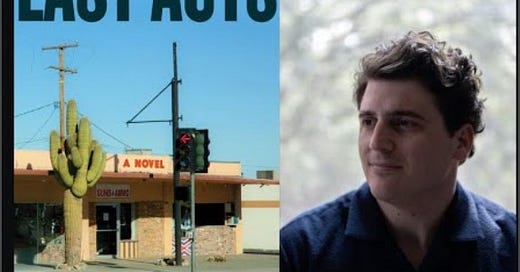🌵 "Last Acts" Book Review: Exploring Family, Addiction, and Resilience in the Southwest
An intense exploration of familial ties, isolation, and hope through the lens of a crumbling gun shop on Arizona's heated landscape.
😽 Keepin’ It Simple Summary for Younger Readers
👧🏾✊🏾👦🏾
📚 Alexander Sammartino's novel, "Last Acts," is about a 👨👦 father and son living in Arizona who try to fix their relationship while facing tough challenges like 🚫 addiction and a 📉 failing business. The story uses real examples, like a hot ☀️ desert and busy 🏙️ streets, to show their struggle to stay close and find hope even when life gets hard.
🗝️ Takeaways
📚 In-depth Character Exploration: Sammartino's novel offers a deep dive into the complex dynamics between a father and son, colored by addiction and economic struggle.
🚧 Urbanization Critique: The book vividly portrays the isolation and desolation bred by modern Arizona's urban sprawl and commercialism.
🌱 Hope Amidst Adversity: Despite harsh realities, the story underscores the resilience and capacity for connection within damaged landscapes.
🔍 Realism in Recovery: Offers a nuanced portrayal of addiction and recovery, reflecting the realities faced by many families.
🌾 Environmental Symbolism: Uses Arizona's physical landscape as a powerful metaphor for personal and cultural struggles.
Desert Dreams and Desperate Measures: A Review of Alexander Sammartino's "Last Acts"
By Maestro Morales, Three Sonorans Reviews
Today I'm reflecting on Alexander Sammartino's debut novel Last Acts – a story that hits closer to home than most, unfolding in the sunbaked sprawl of Phoenix, just a few hours' drive from my own Tucson barrio.
As both a librarian and former mathematics professor, I've developed a habit of analyzing narratives for their underlying patterns and equations. Sammartino's story offers plenty to calculate: one failing gun shop, one recovering addict son, multiplied by desperation, divided by estrangement, all against the backdrop of our shared Sonoran Desert home.
Qué libro tan impactante. It's rare to find contemporary fiction that captures Arizona's contradictions so vividly – the harsh beauty alongside strip mall desolation, the rugged individualism versus our need for community connection.
About the Author and His Desert Debut
Alexander Sammartino emerges as a fresh voice in American fiction with this debut and as someone who grew up in Arizona. Sammartino demonstrates remarkable insight into the psychology of desperation and the particular brand of the American Dream that still draws people to our sunbelt cities despite their increasingly inhospitable climate – both meteorological and economic.
Last Acts joins a growing body of contemporary Southwest literature that examines the region beyond tourist brochures and retirement community advertisements. Much like the works of Tommy Orange, Luis Alberto Urrea, and Leslie Marmon Silko, Sammartino's novel acknowledges that the land itself is a character—one that influences human behavior through its extremes and contradictions.
The Arizona Landscape: Strip Malls and Lost Souls
What struck me most powerfully about Last Acts is its unflinching portrayal of modern Arizona urbanism. David Rizzo's struggling gun shop exists in a landscape many of us recognize but rarely see depicted in literature – the endless commercial strips, the cookie-cutter developments, the asphalt expanses reflecting heat back into an already overburdened atmosphere.
¿Qué pasó con nuestras ciudades bonitas? What happened to our beautiful cities?
Sammartino's descriptions of the commercial strips housing Rizzo's Firearms resonate deeply with those of us who have witnessed the transformation of our Southwestern communities. His vivid portrayal of faded storefronts, payday loan centers, and endless asphalt expanses captures the reality of modern Phoenix urbanism. Where once the desert's natural contours and indigenous wisdom shaped human habitation, we now impose geometric grids and corporate templates with little regard for place or community.
The gun shop becomes a potent metaphor – a business theoretically built on protection and self-reliance that instead contributes to isolation and fear.
As an Indigenous Chicano activist who has fought against unchecked development and for the preservation of Indigenous spaces, I found myself nodding in recognition at Sammartino's subtle critiques. The Phoenix he portrays is a place where human connections struggle to survive in environments designed primarily for commerce, not community. Each strip mall, each six-lane road, becomes another barrier between people like Rizzo and his son – physical manifestations of the emotional distances they struggle to cross.
Como siempre decía mi abuela, "The land remembers even when people forget." In Last Acts, the transformed landscape of metropolitan Phoenix seems to remember its desert origins through the relentless heat that beats down on Rizzo's failing enterprise, the way it extracts moisture and hope with equal efficiency.
The Weight of Addiction in the Desert Heat
Nick Rizzo's overdose and fragile recovery form the emotional core of Last Acts, and Sammartino handles this dimension with remarkable nuance. As someone who has witnessed addiction's impact on families in our communities, I appreciated the author's resistance to both romanticization and demonization. Instead, Nick's addiction is both a personal struggle and a social phenomenon—a reflection of the emptiness that goes beyond individual psychology.
Particularly compelling is how Sammartino connects Nick's substance use to the broader spiritual malaise of contemporary Arizona. In a landscape increasingly defined by transience and consumption, where historical memory and cultural continuity struggle against the bulldozer of development, Nick's search for chemical transcendence reads as an almost predictable response.
No es sorprendente – not surprising – that young people seek escape when their physical environment offers so little genuine connection.
The novel offers powerful insights into Nick's perspective during his hospital recovery. Sammartino contrasts the ancient permanence of distant mountains with the disposable architecture of modern Phoenix, suggesting that Nick's attraction to substances might connect to a search for intensity and meaning in an environment that often feels temporary and bland.
This portrayal resonates with what many of us working in community support roles have witnessed. The epidemic of addiction in our Southwestern communities cannot be separated from questions of meaning, belonging, and connection to place.
When we replace desert paths with parking lots and mutual aid networks with big box stores, is it any wonder our young people seek chemical solutions to existential problems?
Sammartino avoids simplistic moral judgments about Nick's addiction, instead presenting it as a complex response to both personal and environmental factors. The novel's portrayal of recovery is equally nuanced—not a straightforward journey toward wholeness, but a series of delicate steps forward, sometimes interrupted by setbacks backward. For those of us who have supported loved ones through recovery, this rings absolutely true.
Father and Son: A Borderlands Relationship
At its heart, Last Acts is a father-son story exploring the complicated terrain of male relationships across generations. With his failing gun shop and desperate commercial schemes, David Rizzo embodies a version of American masculinity—one defined by self-reliance, business success, and emotional stoicism. His son Nick represents both the continuation and rejection of this legacy, struggling to find his own path while carrying his father's expectations and disappointments.
What makes their relationship especially resonant for readers in the Southwest is how Sammartino frames their conflict within our region's specific challenges. The gun shop itself serves as a powerful metaphor—a business centered on protection and self-defense that paradoxically leaves its owner vulnerable and isolated.
Qué ironía más profunda – what profound irony – that Rizzo's dedication to selling weapons has left him essentially defenseless against economic forces beyond his control.
Throughout the novel, Rizzo grapples with the uncomfortable irony of his situation—a man who has spent years selling protection to strangers while failing to protect what matters most: his relationship with his son.
This contradiction captures the novel's nuanced exploration of masculinity in crisis. Rizzo has followed a traditional script of male success – entrepreneurship, self-sufficiency, emotional restraint – only to find himself failing by these very measures. His desperate plan to use his son's near-death experience as marketing material represents the ultimate corruption of family bonds by market logic, yet Sammartino somehow maintains our sympathy for this profoundly flawed father.
What resonated most with me as a Chicano reader was how the novel explores intergenerational relationships against the backdrop of changing social landscapes. Like many fathers and sons in our communities, Rizzo and Nick must navigate not just personal differences but shifting cultural terrain.
The Arizona that shaped Rizzo's expectations and ambitions is disappearing, while Nick comes of age in a more precarious, disconnected environment. Their struggle to communicate across this divide mirrors many families' challenges in our rapidly transforming borderlands.
Finding Hope in Harsh Landscapes
Despite its unflinching portrayal of addiction, economic struggle, and environmental degradation, Last Acts ultimately offers measured hope—not the facile optimism of Hollywood endings, but something more tenuous and true—the possibility that authentic connection might still be possible even in damaged landscapes.
Late in the novel, Sammartino crafts moments of quiet connection between father and son, often set against the backdrop of Arizona's natural landscape. As the day's light fades and the distant mountains shift in color, we witness small but significant steps toward genuine communication between Rizzo and Nick. These understated scenes of tentative reconnection capture what I found most valuable about Sammartino's novel – its suggestion that healing, while never complete or perfect, remains possible through authentic recognition of shared vulnerability.
En fin, that's what sustains our communities despite development's onslaught and addiction's ravages: our capacity to see each other clearly and stand together in brutal truths.
A Desert Blooming
As I close Sammartino's book and gaze out at my Three Sisters garden—corn, beans, and squash supporting each other as they have in this desert for thousands of years—I'm reminded that resilience takes many forms.
Last Acts offers no easy solutions to the challenges facing our Southwestern communities: addiction, unsustainable development, economic precarity, and familial disconnection. What it does provide is a deep human engagement with these issues, grounded in the specific textures and contradictions of contemporary Arizona.
Sammartino's debut offers valuable insights for readers seeking to understand the complex realities of the modern Southwest beyond tourist brochures and political simplifications. For those who call this complicated region home, it provides a mirror that reflects both our struggles and our enduring capacity for connection despite everything working to keep us isolated.
Last Acts is not an easy read, but like the desert itself, its apparent harshness conceals unexpected depth and beauty for those willing to look beyond surfaces. Sammartino has created characters who will stay with readers long after the final page – flawed, struggling humans doing their imperfect best in a landscape that both challenges and sustains them.
Como decimos en mi comunidad, the desert teaches us that life persists even in the most unlikely places. Sammartino's novel honors this truth while refusing to flinch from the very real damage we inflict on our landscapes and each other. For this Chicano librarian and activist, that honest reckoning makes Last Acts essential reading for anyone seeking to understand the contemporary Southwest in all its contradictory beauty.
Maestro Morales is a social justice indigenous Chicano activist, former college mathematics faculty member, and current librarian based in Southern Arizona. When not reviewing books, he tends his Three Sisters garden and advocates for sustainable, community-centered development throughout the Southwest.







